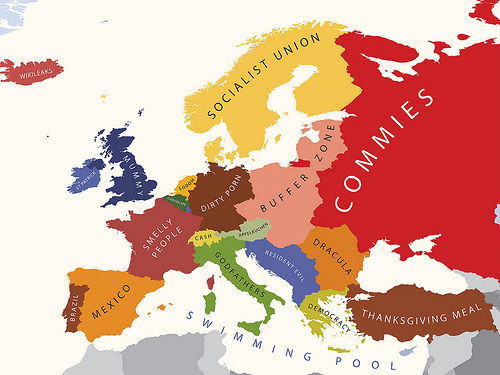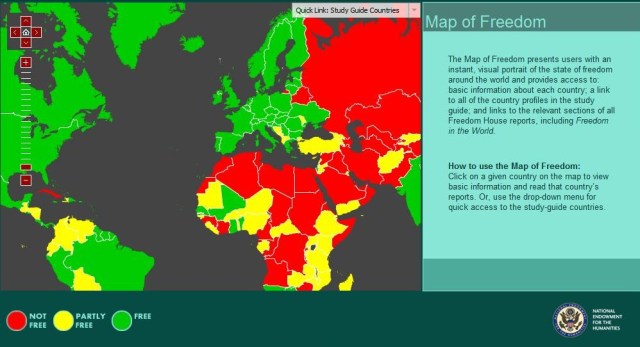I came across two maps today. The first one is a joke; it’s titled “Europe according to the United States of America”:
 As far as I can tell this map is designed to poke fun at and expose American stereotypes of Europe.
As far as I can tell this map is designed to poke fun at and expose American stereotypes of Europe.
The second one should be a joke but isn’t; it’s titled the “Map of Freedom” (it’s an interactive map—click on the screen shot below to see it in motion):
 This map seems designed to reinforce American stereotypes.
This map seems designed to reinforce American stereotypes.
According to the website, it is a product of a group funded by the National Endowment for the Humanities. Here’s some of the content from their “About This Site” page:
In 1987, the American Federation of Teachers, Freedom House, and the Educational Excellence Network cosponsored the release of Education for Democracy, a statement of principles that received wide media attention …. It called on our schools to “purposely impart to their students the learning necessary for an informed, reasoned allegiance to the ideals of a free society,” arguing that “democracy’s survival depends upon our transmitting to each new generation the political vision of liberty and equality that unites us as Americans.” …
The 1987 statement and an updated and expanded version, released in 2003 by the Albert Shanker Institute on the second anniversary of the September 11 terrorist attacks, argued that the story of democracy should be taught as a major theme not just in American history, but in much of world history and social studies. Indeed, said the authors, “the great central drama of modern history has been and continues to be the struggle to establish, preserve, and extend democracy—at home and abroad.” Both documents argued that all students must be provided with a full and fair accounting of the strengths and failings of democratic societies. But it is equally important, they said, that students are provided with a clear picture of the alternatives against which democracy can be measured.
The systematic presentation of reality abroad must be an integral part of the curriculum. What are the political systems in competition with our own, and what is life like for the people under them?
Sadly, most secondary-school textbooks are little help in this regard.
Freedom House has long been a valuable source of accurate information with which to fill this gap. Freedom in the World, its annual comparative survey, documents the range of political systems in the world and the extent to which democratic rights and freedoms are enjoyed by those who live under them. The survey bases its judgments on a series of criteria that give separate scores for a country’s level of political rights and its array of civil liberties, and each country receives an overall designation as Free, Partly Free, or Not Free. As a companion to the survey, Freedom House publishes an annual Map of Freedom, which is color coded to show the freedom designation of each country.
Over the past few years, the American Federation of Teachers and Freedom House have periodically worked together to distribute free copies of the Map of Freedom to any history or social studies teachers who request them. The demand has been overwhelming. Many thousands of teachers have asked for copies of the map, which they praise as a uniquely useful teaching tool for courses on global politics. Democracy Web was designed to take advantage of and expand upon this resource.
… The materials center on an informational website and teachers’ study guide for use with secondary- and college-level students—those who are just commencing their roles as citizens.
I couldn’t help but notice how they push all the rhetorical buttons: “reason,” “freedom,” “democracy,” “liberty,” “equality,” “reality,” “accurate information,” “September 11,” etc.
It’s nice to see superficial categories like “good people” and “bad people” swapped for incredibly sophisticated sorting taxons like “free,” “partly free,” and “not free.” I can’t imagine how a young adult could come away from this map with anything but a more subtle understanding of world politics. (Yes, that’s sarcasm folks.)
Without doubt this map reinforces common American stereotypes: Russia and China are not free (they’re red too!); the Middle East (where those Arabs and Muslims live, you know!) is not free; America is obviously free—it’s smack-dab in the center of the biggest block of green; Israel is free and Palestine is not—and the worst part is that the latter is euphemistically listed as “Palestinian Authority-Administered Territories,” which I cannot believe was written in good faith.
I can’t read this without thinking that “Freedom House” (“Propaganda House”?) used Althusser’s “Ideology and Ideological State Apparatuses” essay as a manual.

